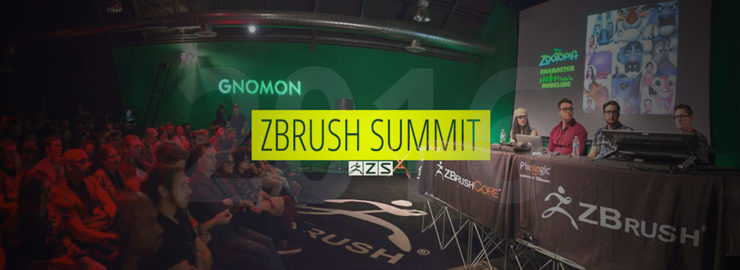Last September, as part of the Walt Disney Animation Studios‘ character modeling team, Pixologic invited us to the ZBrush Pixologic Summit 2016 to talk about our modeling creation process during the production of Disney’s Zootopia.The team of speakers was Zack Petroc, Dylan Ekren, Alena Wooten, Suzan Kim and myself. From here I would like to thank Pixologic again for this amazing experience. Here you will find the recorded version of the presentation and I hope you find it interesting!
WHAT IS THE ZBRUSH SUMMIT?
From September 30th – October 2nd at LA’s prestigious Gnomon School facilities, Pixologic and ZBrush artists from around the world will come together to bring you the ultimate ZBrush experience.
El pasado septiembre, como parte del equipo de modelado de personajes en Walt Disney Animation Studios, Pixologic nos invitó al ZBrush Pixologic Summit 2016 para hablar de nuestro proceso de creación de personajes durante la producción de Disney’s Zootopia. El equipo de ponentes fue Zack Petroc, Dylan Ekren, Alena Wooten, Suzan Kim y yo mismo. Desde aquí me gustaría agradecer de nuevo a Pixologic por la increíble experiencia. Aquí encontraréis la versión grabada de la presentación. ¡Espero que lo encontréis interesante!
Link: Pixologic Summit 2016






Hello Sergi, how are you doing?
I have been following you on the internet to learn about good topology as I recon your amazing artistic and technical expertise.
Watching your presentation at the Zbrush Summit, when you show the beaver and the squirrel (https://youtu.be/pAPT5Cvw60M?t=55m36s), I got confused.
I´d like to learn how those characters share the same topology. Do you have to add any spans specifically for the stretching areas, do you change it using rigging, would it be none of those or maybe a bit of both?
Thanks a lot for creating such beautiful art and sharing with us.
Wish you all the best.
Fredy.
Hi Frederyco,
thanks for your words about my work, I really appreciate them!
As you heard during our presentation, both characters (squirrel & beaver) share the same topology in order to optimize or speed up some process such as skin weighting, texture painting or even grooming maps. So, to create a mesh that could be used for multiple characters with this level of variety, we had to work with meshes around 20k polygons in order to have enough resolution to support the difference on shapes and volumes between them. Also, we settled some specific edgeloops and points for specific areas or landmarks, trying to preserve as much as possible the position of them across the characters. An example of these key loops are elbows, knees, lip/lids creases, etc.
I hope these words answer your questions!
It sure does. Thanks a lot Sergi!